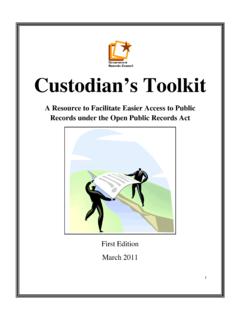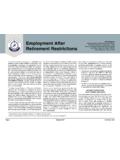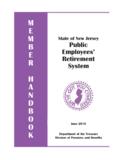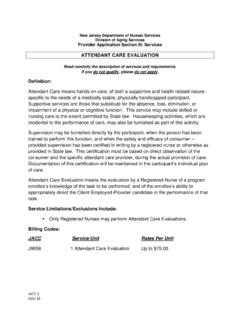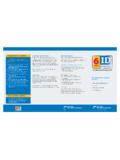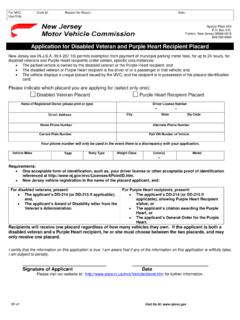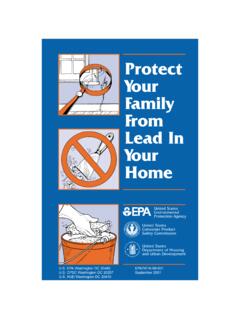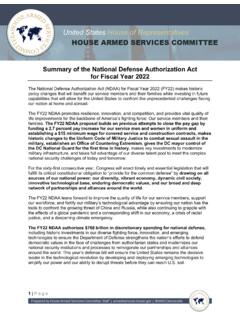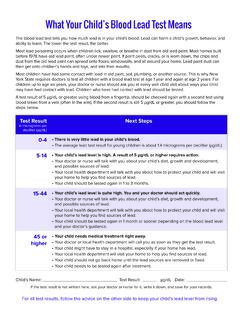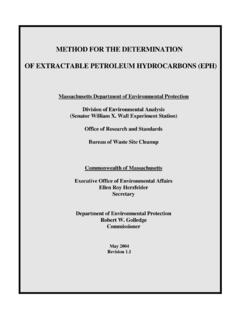Transcription of Protocol for Addressing Extractable Petroleum …
1 New Jersey Department of Environmental Protection Site Remediation Program Protocol For Addressing Extractable Petroleum Hydrocarbons (Version , August 9, 2010). DISCLAIMER. This New Jersey Department of Environmental Protection (Department) guidance is written based upon the method "Analysis of Extractable Petroleum Hydrocarbon Compounds (EPH) in Aqueous and soil /Sediment/Sludge Matrices" (NJDEP EPH Method Revision 3). The Department has implemented a phase-in period of six months for the use of this guidance which is similar in approach the phase-in periods used in the past by the SRP. For additional information regarding the phase-in, refer to the document Phase-in for the implementation of the Protocol for Addressing Extractable Petroleum Hydrocarbons' and the associated analytical method Analysis of Extractable Petroleum Hydrocarbon Compounds (EPH) in Aqueous and soil /Sediment/Sludge Matrices'.
2 ( ). INTRODUCTION. This New Jersey Department of Environmental Protection (Department) guidance document will provide direction on how to address Petroleum hydrocarbon mixture discharges except for those that originate from the more volatile Petroleum hydrocarbon mixtures ( , gasoline, kerosene, jet fuel, and mineral spirits). Volatile Petroleum hydrocarbon mixtures are to be investigated pursuant to the Technical Requirements for Site Remediation (TRSR). Analytical requirements remain as defined pursuant to Table 2-1 ( ). Historically, the Department has used a value of 10,000 mg/kg, which was based on the field capacity to remediate total Petroleum hydrocarbon discharges. The Department is mandated by 58:10B-12 to employ a health-based approach when developing remediation standards.
3 This guidance document provides a health-based approach to accomplish the remediation of Petroleum hydrocarbon mixtures. It should be noted that this guidance document does not preclude compliance with any other Site Remediation Program policies, including the sheen policy ( ). In addition, the person responsible for conducting the remediation shall also comply with the TRSR. including, but not limited to, the requirements to remove and/or treat free and/or residual product ( 7 (d), ). Furthermore, the Department is establishing an ecological screening value of 1,700 mg/kg (established at "Health Based and Ecological Screening Criteria for Petroleum Hydrocarbons - Frequently Asked Questions, Question #3"; ) that is applicable to all Petroleum hydrocarbon discharges if and only if a sensitive environmental resource is potentially impacted by Petroleum hydrocarbon contamination as determined by a baseline ecological evaluation ( 7 ).
4 In these situations, an ecological risk assessment shall be conducted pursuant to 7 in order to establish a site-specific ecological criterion. Note that pursuant to the TRSR, a baseline ecological evaluation is not required at an area of concern that consists of an underground storage tank storing heating oil for on-site consumption in a one to four family residential building ( 7:26E- (a); ). Protocol . The initial task in the Protocol is to determine the current and historical Petroleum hydrocarbon mixtures stored and potentially discharged at the area of concern being investigated, and based on this information, to determine the appropriate Category of discharge being investigated.
5 As noted above, this guidance document does not apply to the more volatile organic compound mixtures: Category 1 consists of discharges of only Number 2 (No. 2) fuel oil and/or diesel fuel. Category 2 consists of discharges of Petroleum hydrocarbon mixtures other than No. 2 fuel oil and/or diesel fuel ( , Number 4 fuel oil, Number 6 fuel oil, hydraulic oils, cutting oils, crude oil, lubricating oil, waste oil, waste vehicular crankcase oil, and waste mineral oil). For those situations where multiple Petroleum hydrocarbon mixtures are involved, the evaluation must address all the types known to be present. For those situations where the product type is unknown, sampling and analytical parameters for waste oil shall be applied.
6 The method "Analysis of Extractable Petroleum hydrocarbon (EPH) compounds in non-aqueous and aqueous matrices" (NJDEP EPH Method Revision 3) will be used as the principal evaluation tool when investigating areas of concern involving both Category 1 and Category 2 discharges. The results of this method will be termed Extractable Petroleum hydrocarbons (EPH). The second task in the Protocol is to determine the human health based EPH remedial goal. For sites with residential exposure scenarios where a Category 1 discharge has occurred, the EPH human health value has already been calculated to be 5,100 mg EPH/kg (see "Frequently Asked Questions for Petroleum Hydrocarbons," Question #1 for a discussion on the derivation of 5,100 mg/kg.)
7 Protocol for Addressing Extractable Petroleum Hydrocarbons Page 2 of 19. Version 08/09/2010. ). In order to perform this calculation, the Department conducted a field study to determine a typical chemical composition for No. 2 fuel oil. Using this average composition, appropriate toxicity information, and current USEPA risk assessment equations, the health- based criterion was developed. For Category 1 discharges at sites with non-residential exposure scenarios, the EPH human health value has already been calculated to be 54,000 mg EPH/kg (see "Frequently Asked Questions for Petroleum Hydrocarbons," Question #1 for a discussion on the derivation of 54,000 mg/kg; ). The person responsible for conducting the remediation shall apply the 54,000 mg EPH/kg criterion as part of the EPH Protocol .
8 The Department has made a policy determination that compliance for Category 1 discharges will use these fixed EPH values, rather than calculated sample-specific values. This decision was reached after consultation with the Department units directly involved with the use and implementation of these criteria. The user should be aware that the Department will continue to evaluate this policy in the future. For Category 2 discharges at sites with both residential and non-residential exposure scenarios, the calculation of the EPH human health value will be accomplished using the spreadsheet provided by the Department at Step by step guidance for the completion of the process will be provided for each of these Category/Exposure Scenario situations following the descriptions of the tasks in the Protocol .
9 The third task in the Protocol is to address any contingency analysis requirements. For Category 1. discharges, analytical requirements for all contingency samples are restricted to only 2- methylnaphthalene and naphthalene. For No. 2 fuel and/or diesel this contingency testing is required if the post-remediation EPH concentrations to remain at the site exceed 1,000 mg EPH/kg. Based on the results of the field study, it was determined that 2-methylnaphthalene and naphthalene, as well as other contaminants, were not of regulatory concern when EPH concentrations were below 1,000 mg/kg. For Category 2 discharges, analytical requirements pursuant to the TRSR, Table 2-1 ("Analytical Requirements for Petroleum Storage and Discharge Areas,".)
10 Apply. This completes the EPH and/or compound specific human health value evaluations. The final task in the Protocol is to evaluate the calculated human health based value against the residual product/free product value; comply with the sheen policy; and apply the ecological values (if appropriate). The final remedial goal will be the applicable value or action that addresses all of the concerns just noted, whether the value or action is EPH based or otherwise. A tabular summary of the Protocol is provided as Appendix 1. The user shall be aware that deviations from this Protocol require Department approval. The Department will consider technical impracticability as a basis for not completing the remediation pursuant to this Protocol .
